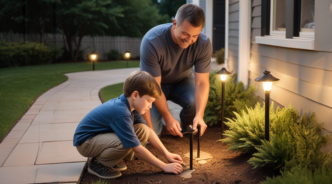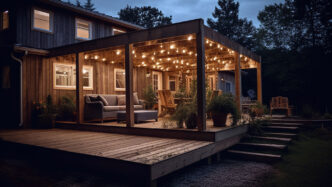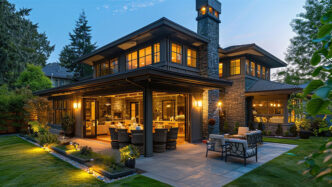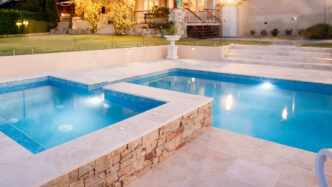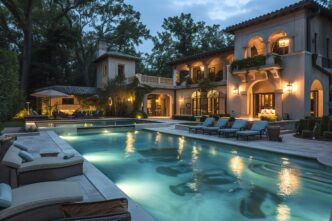When you step into your backyard on a perfect evening when the sun has just dipped below the horizon, what does the scene look like?
As you walk down the path, the soft glow of strategically placed lights begins to illuminate your surroundings. Each step reveals a new layer of your outdoor sanctuary—a tall tree bathed in a gentle upward light, its leaves casting playful shadows that dance in the breeze; the textured surface of your stone wall glowing warmly under the careful wash of light, highlighting every crevice and curve.
The power of well-designed outdoor lighting isn’t just about illumination; it’s about crafting an experience. The right lights can turn an ordinary yard into a place of wonder, but achieving this effect requires more than just picking out a few fixtures—it’s about understanding the right size, the perfect placement, and how to balance light to create harmony with the night.
Let’s dive into how to choose the right outdoor lights for your space.
Choosing the Right Size for Your Outdoor Lights
The size of your outdoor lights impacts not only their aesthetic appeal but also their functionality. Here’s a breakdown of how to choose the right size for each type of light.
- Uplights: Uplights are designed to cast light upward, highlighting trees, statues, or other features. The size of an uplight should be proportional to the feature you’re lighting. For tall trees or large structures, go with uplights with a higher lumen output (800-1200 lumens). For smaller shrubs or garden features, a smaller uplight (400-600 lumens) will do the job.
- Downlights: Downlights cast light downward, ideal for creating a moonlight effect or illuminating specific areas such as outdoor dining spaces. The size of a downlight should correspond to its install height. Higher installations require lights with greater lumen output (1000-1500 lumens), such as when mounting downlights on tall trees or the upper levels of a two-story home. Lower installations, under eaves or on pergolas, can use lights with lower lumen output (500-800 lumens).
- Path Lights: Path lights provide visibility along walkways and driveways. The size of path lights depends on how wide the pathway is and how intense you want the lighting to be. For wider paths, choose taller lights (18-24 inches) with broader beams, like those used along spacious garden walkways or wide driveway entrances. Narrower paths can be lit with shorter lights (12-18 inches) that have a more focused beam, ideal for cozy garden trails or narrow side yard pathways.
- Wall Wash Lights: Wall wash lights spread light evenly across large surfaces such as walls, unlike flood lights, which are more intense and focused. Wall wash lights should be large enough to cover the entire surface area. With a subtle wash, you can softly highlight a garden wall or patio backdrop without overpowering the scene—in which case, choose lights with a wider beam angle (60-120 degrees) and moderate lumen output (800-1000 lumens).
- Flood Lights: For flood lights, the size once again should correspond to the area you need to illuminate. For example, larger areas like driveways or parking lots require lights with higher lumen output (1500-2500 lumens) and a narrower beam angle (30-60 degrees) for focused and intense illumination.
- Deck Lights: Deck lights provide ambient lighting for outdoor seating areas and steps. Deck lights should be small and discreet, usually between 2-4 inches in diameter, with a soft lumen output (200-400 lumens). They are often installed close to the ground or on railings, so the light output should be gentle to avoid glare.
- Hardscape Lights: These lights are integrated into stone or concrete features, such as retaining walls, steps, or patios. Hardscape lights should be compact and linear to blend seamlessly with the structure. Choose lights with low lumen output (200-300 lumens) to create a subtle, integrated look.
The Best Spacing for Your Outdoor Lights
Proper spacing ensures that your outdoor lighting is effective without being overpowering. Here’s how to determine the ideal spacing for different types of outdoor lights.
- Uplights: Uplights should be placed about 6-8 feet apart when illuminating a wall or row of trees. If focusing on individual features, space the lights according to the width of the object, ensuring the light beams overlap slightly for a cohesive look.
- Downlights: Downlights are often installed on trees or structures. When using them for a moonlighting effect, space them 10-15 feet apart, depending on the height of the installation. The goal is to create overlapping pools of light that mimic natural moonlight.
- Path Lights: Path lights should be spaced about 5-8 feet apart to ensure a well-lit walkway without dark gaps. For a more subtle look, stagger the lights on either side of the path rather than placing them directly opposite each other.
- Wall Wash and Flood Lights: Wall wash lights should be spaced about 6-12 feet apart, depending on the width of the surface. For a uniform wash, ensure the beams overlap slightly. Flood lights, on the other hand, should be strategically placed to cover key areas, with each light covering about 20-40 feet depending on the beam angle.
- Deck Lights: Deck lights are typically spaced 4-6 feet apart along railings or steps. The goal is to provide even lighting without creating harsh shadows or glare.
- Hardscape Lights: Hardscape lights should be spaced 3-6 feet apart along walls or steps, depending on the desired lighting effect. For a continuous line of light, space them closer together; for accent lighting, space them further apart.
Buying Outdoor Lights the Right Way
If you’re asking yourself how far apart should outdoor lights be, then you’re already well on your way to transforming your outdoor space into your own creation.
Remember to factor in lumen output, beam angles, and spacing to ensure your outdoor lighting is both effective and aesthetically pleasing. With the right approach, your outdoor spaces can be transformed into a beautifully lit oasis, perfect for relaxation and enjoyment year-round.
Want to illuminate your inbox? Join our Insider list and check out the different landscape lighting options that we have to offer.
